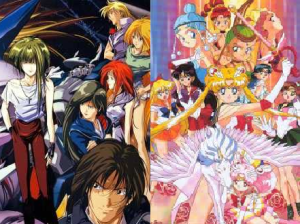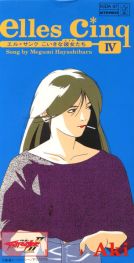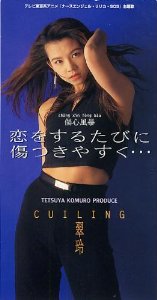
Over the weekend I surpassed the “2,000 items in my physical collection” mark. Can you believe it, 2,000 already! But it did took me 10 years to build it up and I have more to collect. I usually purchase stuff that I can’t find on iTunes or other media sites. I also like stuff that weren’t very popular or just one-hit wonders. And, of course, I like extended 12″ singles, which the local second-hand usually has a lot of.
A 12″ single I recently picked up was “Play Another Slow Jam” by a short-lived R&B girl group named Gyrl. This group was orginally made up of three members: Jamila (who was a dancer in Prince’s “Diamonds and Pearls” video), her sister Miyoko, and Paulette. They started off as backup dancers, under the name Innosence, for the R&B group Immature. It wasn’t until 1995 when the group made their debut with the single “Play Another Slow Jam”. The single reached #74 on the Billboard Top 100 R&B singles.
The group experienced a loss soon after the single’s release as Paulette quit the group. Jamila and Miyoko kept dancing while looking for a replacement. The girls got their wishes answered a while after after when Jeanae’ Briley and Tai-Amber Hoo joined. The now quartet released their second single, “Get Your Groove On”, in 1997. The single, which was featured in the Halle Berry movie “B*A*P*S”, was a success as it reached #30 on the R&B charts. But, the group broke up soon after.
The members went onto focus on different careers. Jenae’ Briley did some songwriting and became a cosmetologist. Tai-Amber Hoo joined Nobody’s Angel in 2001 for a brief time. Miyoko became a stylist. Paulette Maxwell appeared as a dancer on a late 90s’ UPN show “One on One” and composed for another UPN/CW show called “All of Us”. She also became the CEO of her own company, Creation Soul Productions.
However, the most successful member was Jamila, who now goes by the name Mila J. She has appeared on various songs done by Omarion, Treyz Songz, and other artists. The latest song she appeared on was Timberland’s “Don’t Get No Betta”, which its music video was released earlier this year. She made her debut in 2014 by releasing the EP “M.I.L.A”. She is expected to release a full LP by this summer. She recently released a song, entitled “#TBH“, from upcoming LP on Soundcloud.
“Play Another Slow Jam” is a mid-tempo jam that isn’t hard to follow alon. It doesn’t feature a lot of synthesized instruments, opting to a bare instrumentation in favor to feature more of the vocals. Speaking of the vocals, they are a hit or miss depending on which part you listen to. When the girls sing together, the vocals can be very strong and pleasing to listen to. The chorus features the typical 90s’ R&B girl group sound but it’s not overly annoying, it actually sounds pretty nice. However, whenever Paulette or Jamila sing their solo parts, their vocals come off as airy and weak with little or no breath support. Jamila does hav a voice that suits the song well and can control her breathing better than Paulette. Nevertheless, I am going to chalk up the weak vocals to the reason that these girls were pretty young when “Play Another Slow Jam” was released and it was their first song. The second single and the girls’ newer releases prove this as the girls learned from this song and improved their skills.
This Gyrl song isn’t anything too special; it has a basic melody, basic instrumentation, typical R&B sound, and sub-par to weak vocals. But, it’s pretty decent to listen to if you want to remember the 90’s or just want something to chill with.
Besides, doesn’t this song sound like Aaliyah’s “Old School“?


 p song, more than likely it was by Namie Amuro. For the past twenty-three years, Namie Amuro has become a household name as she is everywhere in Japan: CDs, magazine covers, commercials, billboards, pamphlets, and even in stores. Whether it is because of her youthful, beautiful looks or her superb vocal skills, Namie Amuro is a pop icon that will be around for a long time.
p song, more than likely it was by Namie Amuro. For the past twenty-three years, Namie Amuro has become a household name as she is everywhere in Japan: CDs, magazine covers, commercials, billboards, pamphlets, and even in stores. Whether it is because of her youthful, beautiful looks or her superb vocal skills, Namie Amuro is a pop icon that will be around for a long time.

 muro, dance-pop Amuro, or the sultry R&B Amuro, many would agree that over the years, Amuro has had a huge impact on the Japanese pop culture thanks to her music and style. Many artists today and in the past have influenced by Amuro’s style. Even some have tried to copy her, in the case of the 90s’
muro, dance-pop Amuro, or the sultry R&B Amuro, many would agree that over the years, Amuro has had a huge impact on the Japanese pop culture thanks to her music and style. Many artists today and in the past have influenced by Amuro’s style. Even some have tried to copy her, in the case of the 90s’ 



 aracter in the series is Sasami. She was the innocent one of the bunch who didn’t really have to argue or fight for Tenchi’s attention. She just did it naturally, becoming his friend through normal conversations. Even though she is tremendously cute, Sasami has a tragic past. I won’t spoil the details in this blog post. You can watch the OVA episode that explains it all at this
aracter in the series is Sasami. She was the innocent one of the bunch who didn’t really have to argue or fight for Tenchi’s attention. She just did it naturally, becoming his friend through normal conversations. Even though she is tremendously cute, Sasami has a tragic past. I won’t spoil the details in this blog post. You can watch the OVA episode that explains it all at this 














 I got introduced to this magical girl anime by a t-shirt that my dad bought when he was stationed in Korea. I can’t fit in that t-shirt anymore but I still have it in storage, looking at it from time to time because Wedding Peach is a really great anime series (and an even better manga series).
I got introduced to this magical girl anime by a t-shirt that my dad bought when he was stationed in Korea. I can’t fit in that t-shirt anymore but I still have it in storage, looking at it from time to time because Wedding Peach is a really great anime series (and an even better manga series).